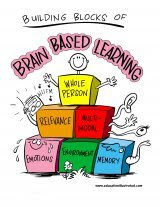A Reflection on Learning Theories and Instruction
As I reflect upon this course, I identify myself with an Adult Learner. As different learning situations present themselves, I am able to move into various learning styles. “-Isms”, within the world of learning theories, “are important but use them as a filter, not as a blinker”. (Kerr, 2007) All the key elements of learning theory, learning style, and technology can be in place, but without addressing the factors of motivation, learning will not be effective. People learn and are motivated in a wide variety of ways. Instructional Design allows us to address learning theories, learning styles, and motivation through technology.
I have found two particular things to be surprising or striking as I further my knowledge about how people learn. First, Howard Gardner states within his description of Multiple Intelligences, “Each individual has a unique blend of the various intelligences that contributes to his/her personal predilections and abilities.”(Dickinson, 2010) Second, “Learning styles can fluctuate within subject or lesson.” (Gilbert, 2008) A learner may identify with a particular learning style but Gardner and Dickinson both show us that learners are able to adapt to the task and move between learning styles because they possess a wide range of intelligences. The learning process is unique to each individual.
This course has deepened my understanding of my personal learning process by introducing me to the characteristics of an Adult Learner. About my personal learning process, I identify myself with at least 4 out of 5 characteristics of an Adult Learner. I am someone who “has an independent self-concept and can direct my own learning”. I have “accumulated a reservoir of life experiences that is a rich resource for learning”. I am also “problem-centered and interested in immediate application of knowledge”. Finally, I am “motivated to learn by internal rather than external factors (Merriam, 2001, p.5)”. (Conlan, 2003) These characteristics are evident in my performance in an online classroom setting and supported by a current grade of 97%. These characteristics also manifest themselves in my role as a classroom teacher and demonstrate my ability to seek and implement new information and learning situations that will enhance my performance within the classroom.
Learning theories, learning styles, educational technology, and motivation are interdependent and necessary for successful learning. Learning theories describe the way a learner acquires and assimilates new information. (Pearson, 2010) Learning styles explain the avenue in which the learner best receives the new information. The different learning styles are auditory, visual, or kinesthetic. (Peggy A. Ertmer, 1993) Educational technology delivers effective instruction. In order for technology to be effective, the basis of delivery is a strong foundation of knowledge in learning theories, learning styles, and motivation. As state previously, learners can move through different learning styles because each learner is equipped with Multiple Intelligence. Yet, the delivery of the content, through technology, must match the appropriate learning theory and learning styles. The ARCS model addresses the area of motivation and allows the Instructional Designer to address the intrinsic and extrinsic factors that motivate learning in the online world. (Keller, Development and use of the ARCS model of instructional design, 1987) Instructional Designers have a delicate task of presenting information so that a wide range of learners is able to acquire new knowledge.
This course will allow me to further my career in Instructional Design because it has given me a foundation in learning theories and learning styles. Technology can enable us to present information based upon the learning theories (Behaviorism, Constructivism, Connectivism, Social Learning, Adult Learning, and Cognitivism). The course has also made me more aware of each learning style. Learning theories and learning styles are important but motivation is the key in delivering the material effectively. As an instructional designer, I need to have all the pieces in place for the instructional material to be effective.
References
Alex Koohang, L. R. (2009). E-Learning and Constructivism: From Theory to Application. Retrieved November 25, 2011, from Interdisciplinary Journal of E-Learning and Learning Objects: http://ijklo.org/Volume5/IJELLOv5p091-109Koohang655.pdf
Behaviorism. (2010). Retrieved 12 12, 11, from Theories of Learning: An Overview: http://eev.liu.edu/know_base/behavior.htm
Conlan, J. G. (2003). Emerging perspectives on learning, teaching, and technology. Retrieved November 29, 2011, from Adult Learning: http://projects.coe.uga.edu/epltt/index.php?title=Adult_Learning#Biography_-_Malcolm_Knowles
Dickinson, D. (2010). Intelligence in Seven Steps: Howard Gardner. Retrieved November 13, 2011, from John Hopkins University School of Education: http://education.jhu.edu/newhorizons/future/creating_the_future/crfut_gardner.cfm
Gilbert, J. &. (2008). Learning Styles: How do they fluctuate? Retrieved from Institute of Learning Styles Journal: http://www.auburn.edu/~witteje/ilsrj/Journal%20Volumes/Fall%202008%20Volume%201%20PDFs/Learning%20Styles%20How%20do%20They%20Fluctuate.pdf
Kapp, K. (January, 2 2007). Out and About: Discussion on Educational Schools of Thought. Retrieved 15 November, 2011, from Kapp Notes: http://www.kaplaneduneering.com/kappnotes/index.php/2007/01/out-and-about-discussion-on-educational/
Keller, J. (1987). Development and use of the ARCS model of instructional design. Journal of Instructional Development , 2-10.
Keller, J. (2006). What is Motivational Design. Retrieved 12 20, 2011, from ARCS Model: http://www.arcsmodel.com/Mot%20dsgn%20Mot%20dsgn.htm
Kerr, B. (2007, January 1). _isms as filter, not blinker. Retrieved November 15, 2011, from Bill Kerr: http://billkerr2.blogspot.com/2007/01/isms-as-filter-not-blinker.html
Pearson. (2010). Learning Theories and Instruction. In Pearson, Learning Theories and Instruction (p. 79). New York: Pearson.
Peggy A. Ertmer, T. J. (1993). Behaviorism, Cognitivism, Constructivism: Comparing Critical Features from an Instructional Design Perspective. Performance Improvement Quarterly , 50-72.
Wynne, R. (2002, June). Characteristics of Adult Learners . Retrieved November 29, 2011, from Asset: http://www.assetproject.info/learner_methodologies/before/characteristics.htm
















